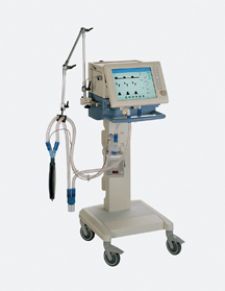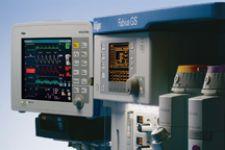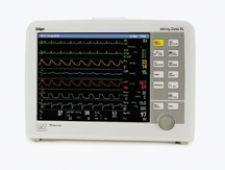
Infinity Delta monitor
Opened in 1952, Wilkes Regional Medical Center is owned by the town of North Wilkesboro, N.C. and is today a 130-bed hospital with a 10-bed skilled nursing unit on the main campus. Offsite outpatient facilities include a Dialysis Center, Home Care and Hospice and a state-of-the-art Rehabilitation and Wellness Center. Wilkes Regional’s comprehensive healthcare services include cardiology, diagnostic imaging, emergency medicine, gastroenterology, intensive care, internal medicine, neurology, general and vascular surgery, urology and women’s services.
In 2003, the center went in search of a company that could provide a long-term solution for its outdated monitoring system. Networking solutions, dependable service and open-architecture platforms were all very important.
According to Wanda Groves, recovery room educator, the old monitors were “nothing but trouble” in the recovery room and ICU. Power glitches would cause continuity problems (e.g., wavy EKG rhythms and drops in the middle) and the lack of reliability was frightening.
The Wilkes Regional staff compared several companies’ technology platforms, history and future plans; viewed various demos; and conducted hands-on testing before selecting Draeger Infinity Delta monitors.
According to Sandy Sheppard, manager of Accreditation and Regulatory Compliance, the monitors’ portability is a key selling point. “Nurses can take the monitor with the patient, simply undo it, and plug into the ICU or recovery room. There is no switching of wires necessary,” she noted. Because of a unique “intelligent docking station,” monitors can be taken from one department to another, docked on the docking station, and left to format themselves automatically to take on the characteristics of the unit to which they are docked.
Dr. V.O. Roberson, medical director of Anesthesia added, “Anyone who has been trained on the monitors can use them in any location.” This allows Wilkes Regional clinicians to do more for patients at the bedside, and be less invasive.
A very important feature of the Delta monitors is that with up to eight channels, clinicians can monitor several different lines at once: pulmonary artery, CVP, arterial lines, respiration rate, oxygen, EKG and blood pressure.
“We can make the technology do what we want it to do — it’s very flexible,” observed Jamie Holloway, manager of Clinical Engineering. Wilkes Regional currently uses the Draeger TruST (True ST) Telemetry Monitoring System to allow clinicians to monitor ST changes in 12-leads on a continuous basis.
Over the last four years, Wilkes Regional has steadily built up its use of Draeger Medical solutions. The center installed — in the fall of 2005 — Fabius GS Anesthesia with Omega monitors to replace its older machines, which did not have the Pressure Support ventilation or other software solutions that Draeger Medical equipment offers. This new technology provides the benefits of more accurate anesthesia delivery, pressure support ventilation, reduced electromagnetic interference and integrated awareness monitoring.
According to Dr. Roberson, the Fabius GS anesthesia machines are “fantastic – so much better than previous ones. Pressure Support — the anesthesia ventilation solution — is fabulous, easy to use, and easy to train on; and the directions on screen are very clear and user-friendly. Our staff loves the new machines, and wishes we’d had them sooner. We couldn’t have gotten a better machine; they are a joy to use.”
Jana Apgar, chief certified registered nurse anesthetist agrees. “We love the Fabius GS system, it helps with requirements for quality control, and shows we’ve checked the machines. Through a five-step process, we make sure the alarms are on and working,” she said.
Wilkes Regional recently purchased Draeger Medical’s Innovian Anesthesia Information system, which will provide a continuous record of patient data from pre-op, through intra-op and post-op. The Innovian system will be hosted on the Omega monitoring system and supports IT applications for the OR. The future IT plans will allow the information to be sent automatically to Wilkes Regional’s QuadraMed HIS platform.
The center also recently acquired the Draeger EvitaXL Ventilator. Its “open-breathing” system helps patients come off the ventilator earlier than before. This can contribute to reduced length of stay and medication costs. With the Draeger Nasal CPAP option, clinicians can ventilate neonates without having to purchase separate, costly devices.
One of the advantages of choosing Draeger Medical across the enterprise is that standardization makes it easier to train the nursing staff. The same monitor is now in use in all critical care areas: anesthesia, PACU, ED, ICU and the cath lab. Moreover, with the Pick and Go system, clinicians transport the patient using the same high-quality monitor (and the same parameters) from department to department without sacrificing patient safety, in accordance with AACN guidelines.
In addition, with the installation of the Draeger EvitaXL Ventilator, the staff will now be able to interface with ICON (Intensive Care Online Network), allowing Wilkes’ clinicians to consult live, 24/7, with physicians, respiratory therapists and intensivists at ICON’s Critical Care Resource Center, located in Linthicum, Md.
Looking toward the future, the new anesthesia, monitoring and telemetry solutions from Draeger Medical support Wilkes Regional’s move to full electronic medical records. The center’s current HIS is being replaced by QuadraMed, which will be able to electronically integrate/interface with all patient care records, including those from monitors, ventilators, ICU, labs, OR, etc.
“With the QuadraMed computer system connecting everything together, we’ll be able to follow the patient from ER to discharge with the same data management system, and capture every piece of data automatically,” said Holloway.
According to Mark Cullison, director of Support Services, having this complete record available and reducing manual keying will enhance nurses’ ability to focus on direct care activities. Wilkes Regional is also anticipating real opportunities for savings through technology: reduced length of stay and decreased medication costs. And when the center implements the Infinity WinView and WebViewer software program, physicians will be able to access critical care patient information from their office, in the cardiopulmonary department or remotely.



